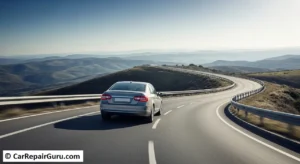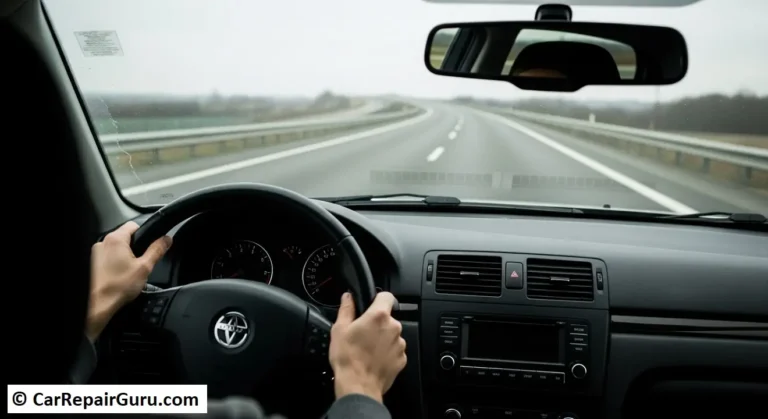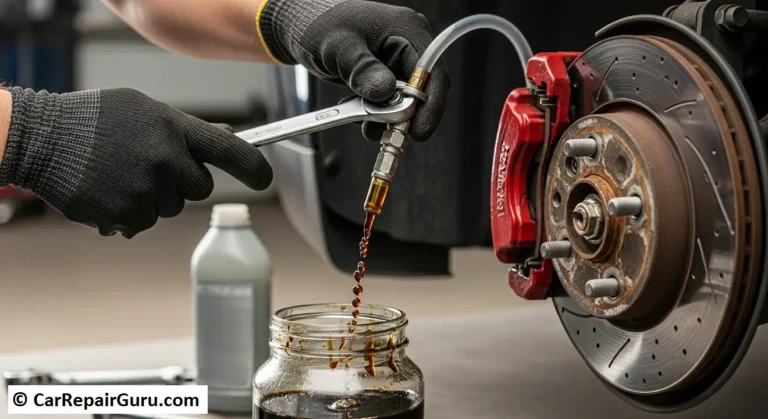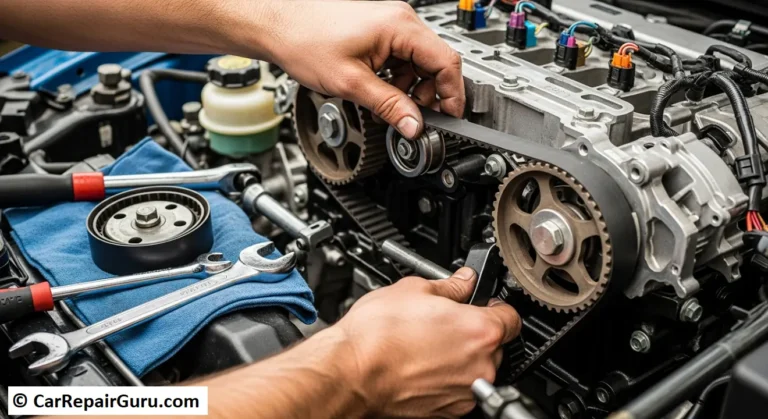
Have you ever taken a highway off-ramp with perfect confidence, feeling the car trace the curve exactly as you intended? Or maybe you’ve had to swerve suddenly to avoid an obstacle and felt that heart-stopping moment where you weren’t sure if the car would listen. That immediate, intuitive connection between you and your machine is the essence of vehicle handling.
Simply put, what is vehicle handling? It’s your car’s ability to respond predictably and precisely to your inputs—steering, braking, and accelerating—while remaining stable. It’s not just about speed; it’s about control.
But why should you care?
- Safety: First and foremost, a car with good handling is a safer car. Predictable behavior allows you to avoid accidents more effectively. When a car responds exactly as you expect in an emergency, you have a much better chance of staying in control.
- Driver Confidence: Good car handling inspires confidence. When you feel connected to the road and know your car will go where you point it, driving becomes less stressful and more enjoyable.
- Performance & Fun: For enthusiasts, handling is everything. It’s the difference between a car that simply gets you from A to B and one that makes you want to take the long, winding road home. It’s the core of a true “driver’s car.”
The Pillars of Vehicle Handling – Key Components Explained
A car’s handling is not one single thing but a complex symphony of parts working in harmony. Understanding these pillars is the first step to mastering your vehicle.
1. Tires – The Only Connection to the Road
Never underestimate your tires. They are the single most critical component for good handling. Your car’s multi-thousand-dollar engine and sophisticated suspension are useless without the four small patches of rubber—each about the size of your hand—that connect you to the pavement.
- Contact Patch: This is the part of the tire physically touching the road. Its shape and size change constantly based on cornering, acceleration, and tire pressure. Maximizing the effectiveness of the contact patch is the goal of all other handling components.
- Tire Grip: The friction generated by the tire’s rubber compound against the road surface. Softer compounds provide more grip but wear out faster, while harder compounds last longer but offer less traction.
- Tire Pressure: Too little pressure causes the sidewalls to flex excessively, leading to a sloppy, unresponsive feel. Too much pressure reduces the size of the contact patch, decreasing grip.
2. Suspension System – Managing Weight and Movement
If tires are the feet, the suspension is the legs. Its job is to manage the vehicle’s weight and keep the tires pressed firmly and evenly onto the road, even over bumps and through corners.
- Springs & Dampers (Shocks/Struts): Springs absorb energy from bumps. Dampers (shock absorbers) control the speed at which the springs compress and rebound. Worn-out shocks are why a car feels “floaty” or bouncy.
- Anti-Roll Bars (Sway Bars): These are metal bars connecting the left and right sides of the suspension. During a turn, they resist the car’s natural tendency to lean or “roll,” helping to keep the body flat and the inside tires on the ground.
- Suspension Geometry: This refers to the specific angles of the wheels in relation to the car and the road (camber, caster, toe). A professional wheel alignment ensures these angles are set correctly, which has a massive impact on stability and tire wear.
3. Chassis and Weight Distribution
The chassis is the car’s skeleton. A stiff, rigid chassis is the foundation upon which a good suspension can do its job effectively.
- Chassis Rigidity: A stiff chassis doesn’t flex or twist under cornering forces, allowing the suspension to move as it was designed to. This results in more predictable and consistent handling.
- Center of Gravity: This is the imaginary point where the vehicle’s entire weight is balanced. A lower center of gravity reduces weight transfer and body roll, making the car feel more stable and planted. It’s why sports cars are built so low to the ground.
- Weight Distribution: This refers to how weight is spread between the front and rear axles. A perfect 50/50 balance is often considered the ideal for neutral, predictable handling.
4. Steering and Brakes
These are your direct lines of communication to the car. A responsive steering system provides clear feedback about what the front tires are doing, while a strong braking system allows you to manage speed and weight transfer effectively before entering a corner.
How Drivetrain Affects Handling – FWD vs. RWD vs. AWD

The wheels that receive the engine’s power fundamentally change a car’s handling dynamics. This is one of the most significant factors in how a car “feels” to drive.
Front-Wheel Drive (FWD) – The Efficient Puller
In an FWD car, the front wheels do all the work—they steer the car and put the power to the ground. This layout is efficient and packages well, which is why it’s used in most passenger cars.
- Handling Characteristics: FWD cars have a natural tendency to understeer. Because the front tires are asked to do two jobs at once, they can become overwhelmed in a corner and lose grip, causing the car to “push” straight ahead. However, this is also a very predictable and stable trait, making FWD cars easy for the average driver to control.
Rear-Wheel Drive (RWD) – The Purist’s Pusher
In an RWD car, there’s a clear separation of duties: the front wheels steer, and the rear wheels push. This is the traditional layout for sports cars and performance sedans.
- Handling Characteristics: By splitting the jobs, RWD cars often achieve better balance and provide purer steering feel. They have a natural tendency to oversteer, where applying too much power can cause the rear tires to lose grip. For an enthusiast, this makes the car feel more agile, engaging, and “rotatable” through a corner.
All-Wheel Drive (AWD) – The Grip Master
AWD systems send power to all four wheels, providing a massive advantage in traction.
- Handling Characteristics: The primary benefit of AWD is superior grip, especially during acceleration and in poor weather conditions like rain or snow. Most road-based AWD systems are designed for stability and will tend to understeer at the limit. However, advanced performance AWD systems can send more power to the rear wheels, giving them the grip of AWD with the dynamic feel of an RWD car.
Understanding the Dynamics – Understeer vs. Oversteer
These two terms describe what happens when a car’s tires exceed their limit of grip. Understanding the difference is crucial for both safety and performance.
What is Understeer? (The “Push”)
Understeer is when you turn the steering wheel, but the car turns less than you intended, continuing to plow straight ahead. This happens when the front tires lose grip before the rear tires. It’s the most common handling characteristic in modern cars because it’s generally easier for an inexperienced driver to manage.
- Common Causes: Entering a corner too fast, worn-out front tires, or applying throttle too early in a corner in a FWD car.
- How to Correct It: The natural (but wrong) instinct is to add more steering. The correct response is to smoothly ease off the throttle to allow weight to transfer back to the front tires, helping them regain grip. Look where you want to go, and the car will follow.
What is Oversteer? (The “Loose” Feeling)
Oversteer is the opposite. It’s when the rear tires lose grip before the front tires, causing the back of the car to swing out or “fishtail.” This is the characteristic that allows for drifting but can be frightening if it happens unexpectedly.
- Common Causes: Applying too much power in a RWD car mid-corner, or abruptly lifting off the throttle in any car (known as lift-off oversteer), which unloads the rear tires.
- How to Correct It: This requires a quicker reaction. You must “counter-steer” by steering into the direction of the slide. For example, if the rear of the car slides to the right, you steer to the right to catch it. This must be paired with smooth, careful throttle control.
The Driver’s Role – Techniques for Mastering Your Car’s Handling
Before you spend a single dollar on upgrades, remember this: the most important component in any car is the driver. You can dramatically improve your car’s handling by refining your technique.
Smoothness is Everything – The Key to Balance
Sudden, jerky movements are the enemy of good handling. Abrupt steering, braking, or acceleration violently shifts the car’s weight, shocking the tires and reducing their available grip. Practice being smooth with every input. Imagine you have a full cup of water on your dashboard and your goal is to not spill a drop.
Understanding and Managing Weight Transfer
This is the art of using your car’s momentum to your advantage.
- When you brake, weight moves forward, pressing down on the front tires and giving them more grip for turning.
- When you accelerate, weight moves backward, pressing down on the rear tires for better traction on corner exit.
A skilled driver uses smooth braking to “load up” the front tires just before turning in, then gently applies the throttle to stabilize the chassis and power out of the corner.
Vision – Look Where You Want to Go
This is the golden rule of driving. Your hands will almost always follow your eyes. In a corner, don’t fixate on the road directly in front of you or the guardrail on the outside. Look far ahead, through the corner, to where you want to end up. This simple trick naturally smoothes out your steering inputs and helps you anticipate the road ahead.
How to Improve Your Vehicle’s Handling – From Basic to Advanced

Ready to take your car’s performance to the next level? Here are some of the most effective ways to how to improve car handling, broken down by budget and complexity.
Tier 1 – Simple & Affordable Improvements (For Everyone)
- Maintain Correct Tire Pressure: This is free! Check your tire pressure at least once a month. The correct pressures are listed on a sticker inside your driver’s side door jamb.
- Get a Professional Wheel Alignment: If your steering feels off or your tires are wearing unevenly, an alignment is the best money you can spend. It ensures your suspension geometry is set to factory spec for optimal stability.
- Upgrade Your Tires: As we’ve said, tires are everything. Investing in a set of high-quality performance tires will provide a more significant improvement in grip and steering response than any other single modification.
- Reduce Unnecessary Weight: Remove any heavy junk from your trunk. Less weight means the car can accelerate, brake, and turn more quickly.
Tier 2 – Enthusiast & Performance Upgrades
- Performance Suspension (Springs & Coilovers): Upgraded lowering springs combined with performance dampers can lower the car’s center of gravity and stiffen the ride. Coilovers are a more advanced solution that offers adjustability for ride height and damping.
- Stiffer Anti-Roll Bars (Sway Bars): Upgrading your sway bars is one of the most effective ways to reduce body roll, keeping the car flatter and more composed through turns.
- Chassis Bracing: Adding components like a front strut tower bar can increase chassis rigidity, leading to sharper and more precise steering feel.
- Brake Upgrades: Better brake pads and high-performance brake fluid can prevent brake fade during spirited driving, ensuring your car stops as well as it goes.
Signs Your Vehicle’s Handling is Compromised
Your car will often tell you when something is wrong. Pay attention to these signs of bad handling, as they could indicate a safety issue.
- Vague or “Loose” Steering: A feeling of disconnectedness or a delay between turning the wheel and the car responding.
- Pulling to One Side: The car drifts to the left or right when you’re trying to drive straight. This is a classic sign of an alignment problem.
- Excessive Body Roll: The car leans heavily and uncomfortably in corners.
- A “Floaty” or Bouncy Ride: After hitting a bump, the car continues to bounce up and down. This is a tell-tale sign of worn-out shocks or struts.
- Unusual Noises: Clunking, squeaking, or grinding sounds when turning or going over bumps often point to worn suspension components like ball joints or bushings.
- Uneven Tire Wear: This is a clear visual indicator that your alignment is off or another suspension part is failing.
The Final Turn – A Balance of Parts
Mastering vehicle handling is about understanding that a car is more than just a collection of parts; it’s a balanced system. The tires, suspension, chassis, and even the driver must all work together in perfect sync. Whether you’re simply ensuring your daily driver is safe and predictable or fine-tuning your weekend sports car for the perfect corner, the principles remain the same.
Great handling isn’t just about going faster—it’s about control, confidence, and ultimately, the pure joy of a machine that feels like an extension of yourself.
Frequently Asked Questions About Vehicle Handling
Does lowering a car always improve handling?
Not always. Lowering a car properly with a quality spring/damper set or coilovers can improve handling by lowering the center of gravity. However, if done incorrectly (like by cutting the springs), it can ruin the suspension geometry and make handling significantly worse and more dangerous.
What is the single most important component for good handling?
Tires. Without a doubt. All the power, braking, and suspension forces are transmitted to the road through four small contact patches. Upgrading from mediocre tires to great ones will transform how your car feels.
Is FWD, RWD, or AWD better for handling?
Each has its strengths. RWD is traditionally favored by enthusiasts for its balance and dynamic feel. AWD offers unbeatable traction and all-weather security. Modern FWD cars, especially “hot hatches,” can handle exceptionally well thanks to advanced suspension design and electronic aids. The “best” depends on your priorities.
How does aerodynamic downforce affect handling?
At high speeds, aerodynamic elements like spoilers, wings, and splitters use airflow to push the car down onto the road. This increases the load on the tires, creating more grip and high-speed stability than would be possible from mechanical grip alone.






